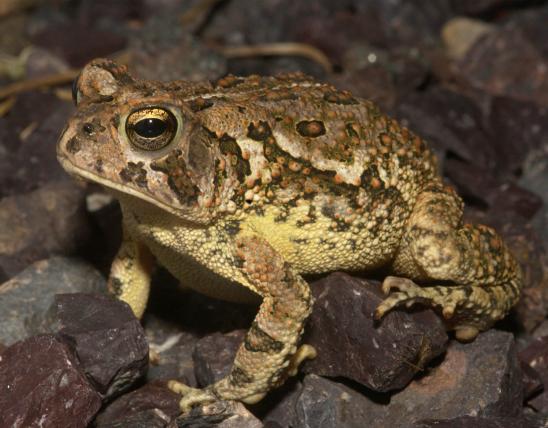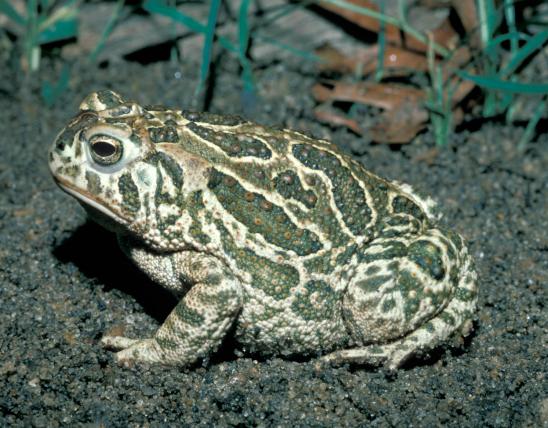
The eastern spadefoot is a stout, toadlike amphibian with large, protruding eyes, vertically elliptical (oval) pupils, short legs, and large feet. Behind each eye is a small, inconspicuous parotoid gland (resembling a wart). There is no raised area (boss) between the eyes. Overall color is light brown to yellow brown. The head, back, and upper parts of the legs are mottled with dark brown. The amount of dark brown on the back may be great enough to form 2 or 3 light yellow-brown, lengthwise stripes in a pattern resembling a lyre. The belly is pale white to gray. The inner surface of each hind foot has a sickle-shaped spur or “spade.”
The male's call is a coarse wank, berrr, or errrah that is repeated every few seconds. Some say it sounds like a young crow. A chorus sounds like a quacking orchestra of countless wanks.
Spadefoots are known to produce skin secretions that can be noxious to other animals. When handling a spadefoot, it is best to avoid touching your face or eyes until you have washed your hands.
Similar species: The plains spadefoot, which occurs in counties along the Missouri River, is distinguished by the presence of a boss (a raised area) between the eyes and by having a wedge-shaped spade at the base of each hind foot.
Taxonomy: Often called spadefoot toads, spadefoots are not true toads, nor are they true frogs, either. Members of this amphibian family are called spadefoots because of the spadelike spur on the inner surface of their hind feet that helps them to dig their burrows.
Note that another spadefoot species, Hurter’s spadefoot (Scaphiopus hurterii), occurs in states near Missouri's southwestern border. It could potentially expand its range into our southern and western counties. To date, however, Hurter’s spadefoot has not been found in Missouri.
Adult length (snout to vent): 1¾–2¼ inches; occasionally to 3 inches.

Eastern counties along the Mississippi River and in southeastern Missouri.
Habitat and Conservation
Eastern spadefoots apparently prefer open fields where loose sand and soil facilitate burrowing. They may occasionally be found in wooded areas, too.
In our state, this species is most common in the sand prairies and sand savannas of southeastern Missouri. They are seldom seen except during breeding season (usually between March and June).
Eastern spadefoots spend most of their time in burrows dug with their hind feet. They are nocturnal and become active on warm, damp, or rainy nights.
Food
The diet includes a variety of invertebrates, especially ants, beetles, flies, grasshoppers, crickets, termites, and worms.
Status
A Missouri species of conservation concern because of its restricted range, the destruction or modification of natural sand prairies, and limited knowledge of its basic biology.
Taxonomy: The North American spadefoot family is represented by two genera, Scaphiopus and Spea, and only two of them occur in Missouri. Spadefoots, often called spadefoot toads, are not true toads (family Bufonidae), although they resemble toads in general appearance and habits. The name "spadefoot" comes from a special tubercle on the hind feet that is shaped like a spade and is used for digging into sand and soil; spadefoots are highly adapted for living underground, and they are explosive breeders in temporary, seasonal pools. They have smoother skin than true toads (genus Anaxyrus), and the pupils of their eyes are vertical.
Life Cycle
Breeding occurs after heavy rains, usually between March and June in southeastern Missouri. Some years, however, warm, heavy rains in February cause early breeding. This species is also likely to breed after heavy rains in the summer. Heavy rains (over 1 inch) are needed to stimulate breeding aggregations. If heavy rains do not occur, spadefoots will not breed during that season.
Most breeding takes place after sunset after heavy rains, but daytime chorusing may occur during favorable weather. Eastern spadefoots breed in temporarily flooded fields, ditches, or other fishless, temporary pools. In Missouri, a breeding chorus generally comprises 20–40 calling individuals. But during favorable weather conditions, it is not uncommon to hear a very large chorus; exceptionally heavy rains can stimulate thousands of individual spadefoots to breed. Interestingly, these explosive breeders may be nearly silent the night following the largest choruses.
The tangled eggs are laid in loose, wide strands or bands 1–3 inches wide and 1–12 inches long and are attached to submerged vegetation or twigs. A female can produce 1,000–2,500 eggs or more. Eggs hatch in 1–15 days, and tadpoles can metamorphose in 2–5 or more weeks, depending on water temperature.
Human Connections
Along the Mississippi River and in the Bootheel, extensive agriculture and urban development in former sand prairie habitat has destroyed and modified many of the natural ephemeral pools where spadefoots breed. Recent surveys have shown that spadefoots are more common than once believed in southeastern Missouri. To keep populations healthy, people should maintain the fishless, temporary wetlands within former sand prairie habitat that this species requires for breeding and tadpole growth.
Just when you think you have sorted all the animals you know into easy categories, you encounter a toadlike creature that is neither toad nor frog. The vertical pupils are a clue that something’s strange here — true toads’ pupils are horizontal! There is always something new to discover in nature.
Ecosystem Connections
A predator of insects, the eastern spadefoot and a host of other small insectivores function to control the populations of the hosts of those creatures. Meanwhile, the frogs, and their own thousands of eggs and many tadpoles, are eaten by larger predators.
































